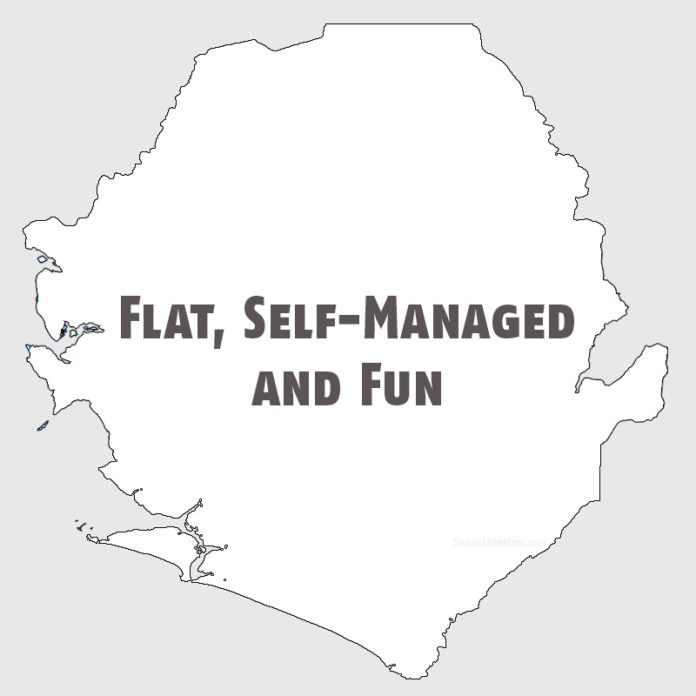
By Mahmud Tim Kargbo
More is expected from the workplace than ever before. The Government of President Julius Maada Bio is asked to develop foundational skills (compensate for the school systems). The government of President Bio is expected to be a place all employees can find fulfilment and meaning (compensate for the home, mosques and the churches). President Bio’s government is expected to provide national collaboration, harmony and happiness (no conflict or difficulties please; can’t we all be winners?) and all this should be done with no leaders (authority is so twenty-first century and giving orders is not acceptable). So the question is: Is the government in Sierra Leone changing for the better?
Consider three popular change themes.
1. Change the Authority:
No Managers. Management is in disrepute and not necessary (much like your big toe!). “Don’t manage people, manage things” is the current mantra. If we eliminate all managers (leave the leaders, they are good), government, departments, agencies and employees will be better off.
The goal of change: Create self-management, autonomy
Reason not to change: Leadership work is necessary. Planning, organising, managing and evaluating are required in every successful endeavour. No matter who does the work, the work has to be done or government, department or agency will end up in chaos. While minimising the number of management positions is proper, there is a danger that the current hostility toward “leadership” will diminish the important contributions of the management function. Even more important is the issue of creating alignment of individual and group efforts.
Better option: When people complain about leadership in Sierra Leone, they usually are complaining about an autocratic style. People chaff if a person with authority lords that authority over them.
An autocratic leader who issues orders, who communicates one way, and, who only provides negative feedback will not create winning teams. The solution, however, is not to remove all management, but to make management work the way it was intended. Leaders in Sierra Leone (late President Ahmad Tejan Kabbah) who simultaneously maximise a high concern for people with a high concern for productivity are worth their weight in gold. That is the type of leader that builds high-achieving government, departments and agencies.
2. Change the Structure:
No Levels Hierarchy is also in disrepute. Organisational levels are seen as barriers to individual freedom and autonomy. People envision an organisation with no levels, no job titles and no bosses. Thus, the holacracy movement. The problems with holacracy are several:
1. In a holacracy there are rigid hierarchies, not of individuals, but of circles of employees.
2. In each circle there are roles and those roles include management
.3. The skills required for a holacracy to be successful are greater than in normal organisations.
The goal of change: Create self-management, autonomy
Reason not to change: Structures will not significantly change President Bio’s government or a department or agency very much because “culture eats structure (not just strategy) for breakfast”.
- Structure change is often done in the hope that moving boxes on a chart will change the government or any other department or agency. Many times structure only creates an illusion of change in Sierra Leone.
- Before leaders select the best structure, there must be rational thought about what they want the structure change to accomplish. Jumping to a new structure (no matter how popular the concept) without having specific objectives in mind seldom works.
- There is no perfect structure. All structures have inherent strengths and weaknesses. When a structure is changed, certain aspects may be improved, but other structural weaknesses will be created. Those weaknesses must be managed (and the systems or skills to do so often are not in place).
- A structure never solves behavioural or cultural problems.
Better option: the ordinary man or Employees who long for the “no-boss” freedom of a holacracy will be dismayed when they find working in teams requires as much or more management; and, management is divided among multiple team members all of whom must plan, organise, lead and evaluate their efforts. An alternative is to develop and use collaboration skills within the current structure.
3. Change the Culture:
No unsatisfying work wouldn’t government departments or agencies in Sierra Leone be much more effective and better places to work if everyone was happy? How could anyone argue with that truism? Plus, the happiness movement claims two major benefits:
1. If people are happy, government, departments, agencies and companies will be much more productive.“Recent research coming out of Warwick University has concluded that happiness levels can increase productivity by a staggering 12%. Increasing the team’s mental and emotional adaptability, no matter what the circumstances, will improve the bottom line.” (“Boost Profits with Happiness Management” by Martin Murphy)
2. If people are happy, government, departments, agencies or companies will be more cooperative.
Consider this piece of research: Three-member teams in which one person was in a good mood are more than twice as likely to collectively solve a murder-mystery puzzle as teams in which all members were in neutral moods. Why? People in good moods are more likely to seek information from others and to share their own knowledge. So, start a meeting with a funny story to put people in a good mood and you may get a better exchange of information and better decision-making. (“Who’s bringing the doughnuts: The role of affective patterns in group decision-making”). If one action improves an agency, department or a government’s productivity by 12% and enhances decision-making, all leaders should adopt that technique Goal of change: Enhance self-esteem, and create contented, happy employees.
Reason not to change: Frederick Herzberg provided sound insights into the two major aspects of motivation. The first facet he called motivators which create true job satisfaction (factors are directly related to the person’s work). The second facet is hygiene factors (factors in the workplace, but peripheral to the work). These factors motivate ordinary people or employees, but if not done well, will de-motivate them. Focusing on happy activities is a hygiene factor which will never result in true work satisfaction.
Better Option: Making ordinary people or employees happy is an impossible task. Concentrate on true employee engagement around meaningful work. That is the recipe for satisfied employees. It appears the government of President Bio is neglecting the basics and chasing fads. If this is the case, are we settling for mediocrity rather than building the infrastructure and skills that will truly create a high-achieving government, departments and agencies?
What are your thoughts? Are flatter, self-managed and fun work organisations the wave of the future? Are we better off making current approaches work or making major changes to the way we work? Is our government, departments, agencies or companies being asked to compensate for parts of society which are not effective? If so, what other changes will we see?

